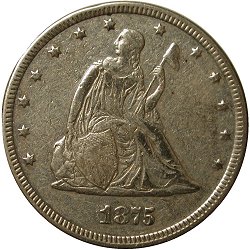Scarcity and Pattern Collecting
As is the case for most true patterns, mintages were extremely limited. Because these pieces were not coins, but rather to test and demonstrate proposed designs, compositions, striking
characteristics, appearances, etc., there was simply no reason to make many of them. Pattern twenty-cent pieces were no exception. Most of the true patterns in silver had mintages of
a couple dozen pieces or less, and in some cases, much less. This was all that was necessary to serve their purpose. To satisfy collectors (both Mint employees and numismatists), a
number of die trial strikes were made in off-metal format to meet this demand. This practice had been going on since the 1850s.
Today, most of the patterns listed above are known by fewer than 20 pieces, with one of the “more common” patterns with a population a little over that. As a result, finding a twenty-cent
pattern will mostly be accomplished at auction, or by working with dealers specializing in patterns.
Interestingly enough, a few of these patterns entered circulation, or became somebody’s lucky pocket piece. One of the more popular patterns, the 1875 1/5 OF A DOLLAR pattern
(reference Judd-1407), has two known circulated examples. A low grade example that was likely a pocket piece, with smooth, mark-free surfaces, grades no more than Good. The other
example, pictured below, is a Very Fine example that shows the handling and contact marks usually associated with a coin having been in circulation.
 |
 |
|
Circulated example of the 1875 Pattern, Judd-1407 |
At least two other twenty-cent patterns are known in circulated condition, and all are extremely rare in these grades, as the pieces were not intended for commercial use.
For the collector of patterns, some excellent references include United States Patterns,
Trial Strikes, and Experimental Pieces, by Dr. J. Hewitt Judd, and the US Pattern Collectors Society and their
associated website USPATTERNS.COM. More details can be found in
References and Related Reading.
